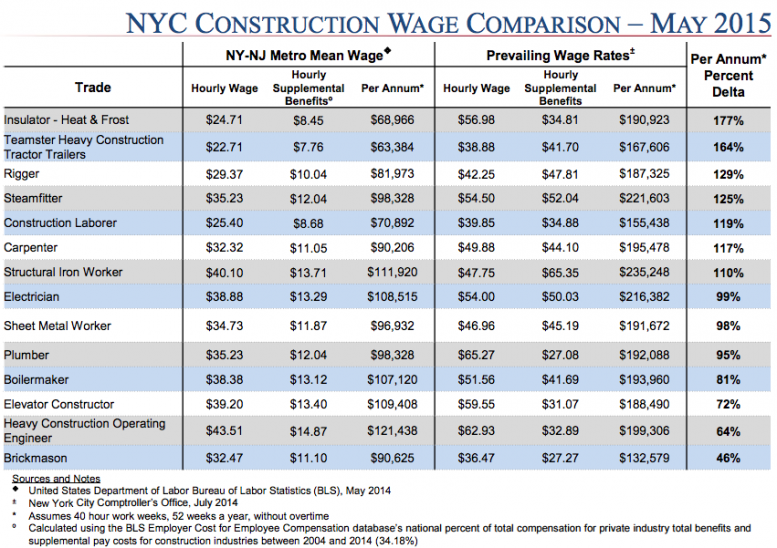New York City’s infrastructure crisis stems from many issues, but one of the biggest problems in maintaining and expanding the city’s arteries are construction costs, which have ballooned into a stratosphere of unknown numbers and complete non-transparency on the part of city agencies. But now YIMBY has obtained data showing that salaries are up to 177% higher for unionized employees of contractors performing public works projects and building service work for government agencies than the prevailing wages of their respective private industry counterparts.
The gap in pay is unsurprising considering the lack of transparency when it comes to New York’s major public works projects, and bloated salaries often hide gross corruption in local politics. The MTA is currently seeking to close a $14 billion gap in its five-year capital plan, yet it cannot tell the public how a $1.5 billion downpayment on the second phase of the Second Avenue Subway will be spent, or what specifically it is for.

Michael Bloomberg “opening” the 7 train extension, which is still not actually open. Photo by the MTA’s Patrick Cashin.
Data shows that the difference in pay is largest for insulators who make $68,996 if employed by private industry. When on the dole for government or public work projects, they make an average of $190,223, which is a jump of 177%.
Similarly jaw-dropping increases hold true across other professions in the construction trades, with the highest salary going to structural iron workers, who take home an average of $235,248 on government projects, compared to $111,920 normally. Steamfitters come in second, with $221,603 vs $98,328, and electricians in third, with $216,382 vs. $108,515.
High salaries in and of themselves are a good thing, but when the discrepancy is due to corruption and a lack of transparency rather than legitimate competition, the city does not benefit. Instead, New York City is faced with plans that waste billions of taxpayer dollars, with labor costs that are beyond absurd a major causative factor.
Subscribe to YIMBY’s daily e-mail
Follow YIMBYgram for real-time photo updates
Like YIMBY on Facebook
Follow YIMBY’s Twitter for the latest in YIMBYnews


You don’t help your credibility with readers by writing such loaded phrases as “when on the dole for government.”
I don’t doubt the gist of your figures, although it would be great to have a link to the chart you embed. Prevailing wage laws can make projects very expensive.
However – the workers are not TAKING HOME the numbers you quote. ” That is their total benefits” Including health insurance and pension 401K matching etc. etc. It’d be nice to know how those “supplemental benefits” are calculated. It’s hard to believe that hourly benefits exceed hourly salary in many cases.
It would have better served your claim for transparency if you had included some information of how the prevailing wage is calculated by the government. If you are alleging corruption than I look forward to your follow-up article that will shed more light on that subject.
So, basically, you guys are complaining because the government demands that you pay workers what they are actually worth on public works jobs, instead of paying sweatshop wages?
Simple solution – pay prevailing wage ON ALL OF YOUR JOBS.
They build the buildings – you just own them. Their labor makes you rich – share the wealth with the men and women who created it for you.
I’m surprised that requiring unions on government contracts isn’t illegal yet. Unions have past their usefulness and are essentially the modern day mafia. Unions need to be abolished or the the prosperity of this country will eventually disappear
The stats for private industry wage rates are total junk. Most of the wage numbers are taken from the Combined Statistical Area tables, which include areas as far afield as parts of Pennsylvania, not the more detailed statistics for the city (which are usually 20-25% higher).
Worse, using a national ratio for the private supplemental benefits payments makes almost no sense at all. It’s a total extrapolation, including states with very different labor laws and very different costs of living. There have been studies that suggest that supplemental benefits are about 240% higher in the public sector, but their methodologies tend to be dubious (they usually fail to account for the different ways private and public employers pay for benefits).
All in all, this looks like cherry-picked numbers designed to produce the largest difference. I’m strongly against prevailing wage laws, but this analysis is a weak one.